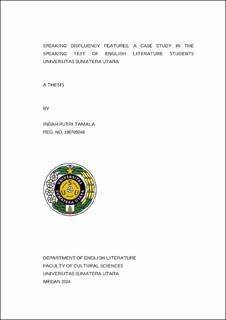Speaking Disfluency Features, A Case Study in The Speaking Test of English Literature Students Universitas Sumatera Utara

Date
2024Author
Tamala, Indah Putri
Advisor(s)
Sofyan, Rudy
Sumbayak, Desri Maria
Metadata
Show full item recordAbstract
This study examines the dominant types of speaking disfluency and the factors
influencing speaking performance among English Literature students in the Basic
Speaking 2022/2023 class. Using Clark and Wasow's (1998) framework, the
research focuses on five categories of disfluency: fillers, silent pauses, repetitions,
false starts, and hesitations, excluding prolongation and grammatical errors to
concentrate on performance-related issues. A sample of 30 students delivered
speeches on topics such as business, gadgets, and childhood, which were recorded
and transcribed for analysis. The findings reveal that fillers are the most prevalent
type of disfluency, constituting 48% of all instances, followed by repetitions
(21%), silent pauses (16%), false starts (10%), and hesitations (5%). The study
identifies lexical retrieval challenges as a primary cognitive factor contributing to
disfluency, exacerbated by insufficient vocabulary and inadequate speech
preparation. Additionally, high levels of speaking anxiety correlate with increased
disfluency, while more proficient students exhibit lower filler usage. The
complexity of the speaking tasks also influences disfluency rates, particularly
when students encounter unfamiliar or challenging topics. Affective factors, such
as language anxiety and self-confidence, further contribute to the occurrence of
disfluencies. These findings highlight the need for targeted language education
strategies to improve fluency and boost students’ confidence in speaking.
Collections
- Undergraduate Theses [874]
